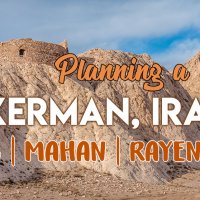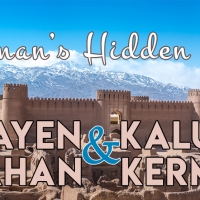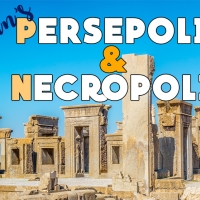- The Middle East Trip: Intro
- Middle East Trip: Arriving in Tehran
- Middle East Trip: Exploring Tehran – Part 1
- Middle East Trip: Exploring Tehran – Part 2
- Middle East Trip: Esfahan – Half of the World
- Middle East Trip: Exploring Esfahan Continues
- Middle East Trip: Our Host in Esfahan
- Middle East Trip: Yazd – The City of Zoroastrianism
- Middle East Trip: A Tour of Persepolis et al
- Middle East Trip: Picnic in Shiraz
- Middle East Trip: Shiraz – Home of Hafez
- Middle East Trip: Back in Tehran
- Middle East Trip: Istanbul – En Route & Arrival
- Middle East Trip: Kind-Hearted Souls in Istanbul
- Middle East Trip: From Amman to Petra, Jordan
- Middle East Trip: CouchSurfing in a Jordanian Cave?
- Middle East Trip: Revisiting the Exquisite Petra
10 January 2012
On the slope of Jabal al-Madhbah, in the Valley of Moses (Wadi Musa), lies the ancient city of Petra. When Nabataeans took over the city from Edomites and made it into the capital of their kingdom, the city gained status as it stood at one of the most important trade routes in Arabia. Caravans passed through Petra, carrying spices and textiles from Arabia to Syria, allowing the city to collect taxes from traders. The Nabataeans also developed their own extraordinary water system, which enabled the city to flourish even during prolonged periods of drought. Petra continued to prosper after Romans took over and eventually declined due to the change in trade routes. The earthquakes that devastated the whole area also brought the Rose City to ruin. It was not until 1812 that Petra was revealed to the Western World. Since then, the site has not lost its spotlight and historical importance as it became a UNESCO World Heritage Site in 1985. It is also the most visited tourist attraction in Jordan. This is a must-visit site if you happen to be in Jordan!
The Siq
To enter the ancient city of Petra, one must walk through a beautiful narrow gorge, known as The Siq. During the Nabataeans period, the Siq was used as the grand caravan entrance into Petra. This passage that I am walking now is more than 2,000 years old! How awesome is that!!! The path is beautiful (and we have not even reach Petra yet!). There are so many natural wonders you can discover here. I can see different rock formations and mountain cracks due to erosion. The smoothness of these rocks are amazing and there are some lines (water lines, perhaps?) carved randomly. The rocks have incredible colours too! I think we are very lucky that the weather is perfectly sunny today. Otherwise, we will not be able to enjoy that view!
The Treasury
Towards the end of the narrow passage, bit by bit, one of the greatest monument of Petra emerges into view. I catch a first glimpse of the Treasury (Al Khazneh) as if discovering a light at the end of a tunnel. This is the most beautiful rock-cut facade I have ever seen. No words can perfectly describe such an awe-inspiring structure, carved out of a sandstone rock cliff. Even pictures don’t do justice to this magnificent piece of art! How can you appreciate the beauty of this monument at night?! I am glad I am here during the day!
As we walk passed the Treasury, more and more rock-cut tombs appear on the sandstone cliffs. Known as the Street of Facades, the tombs are decorated with elaborate facades. The wealthier the Nabataean family was, the bigger and more complex (in design) the tomb was built. Display of wealth was part of Nabataean culture at that time, apparently!
After admiring the Street of Facades and a number of other monuments, we start to hike up a hill, steps after steps. I cannot imagine going up this hill during summer though! In the winter, it is just perfect. Bright blue sky, occasional breeze, and blazing sun make a perfect combination for a relaxing hike. From time to time, one or two donkeys pass by, clattering the rocky steps of the hill, each carrying a tourist on its back. We keep on hiking all the way to the top, until the last 850th steps. I actually did not know what to expect of this hike. I knew we were going to see a monument, but that was it! Little did I know that I was going to see something even more magnificent than The Treasury!
The Monastery
It is called the Monastery, or in Arabic: Al Deir. This 48-meters-high monument looks similar to the Treasury, but it is more massive than other monuments that I have seen around Petra. The Monastery itself was used as a temple when the Nabataean rules the kingdom. Some scratches of crosses and an altar inside the monument indicated that it was probably used as a church in the later years. I have to say, the 850 steps are definitely worth it! There is even a restaurant in front of the Monastery. Drinking a cup of tea while enjoying the beauty of this monument and its surroundings seems to be a great idea!
Royal Tombs
On our way back to the Treasury, I decided to do another short hike to Royal Tombs. The structures of the tombs here are less elaborated due to wind and rain but that’s what make them beautiful. I love the dramatic mixture of colours on one of the tombs (pictured below – middle). Beautiful, isn’t it? Imperfections make these structures perfect.
In a nutshell, Petra does have a strong resemblance of another Nabataean city, Madain Saleh, which I had the opportunity to visit a few years ago. Compared to Madain Saleh, Petra has more variety of tomb designs and structures — I love Petra for that. I don’t mind to go here again when I have the chance. For now, au revoir, Petra!




